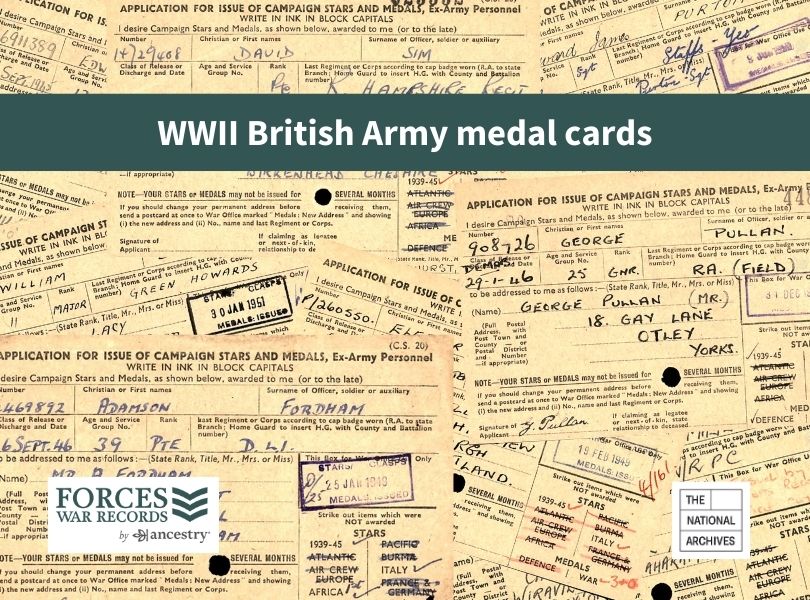Historically significant WW2 army medal cards available to search online for the first time
Calling all military genealogists: we are excited to announce the release of the WW2 army medal cards on Forces War Records. We have worked tirelessly with our partners at The Ministry of Defence (MOD) and The National Archives (TNA) to bring you this groundbreaking collection, which you can now search online for the first time. The medal cards are a must-search for anyone researching their WW2 British Army ancestors and exploring their family connection to this pivotal moment in British history. But what are the medal cards, what do they tell us, and how can they help you research your military ancestors? Read on as we answer these questions and guide you through this exciting new set of WW2 records.
What are the WW2 army medal cards?
The WW2 army medal cards are application cards, known as C.S. 20, which soldiers of the British Army and other units administered by the War Office could fill out and send to the War Office after the war to claim the campaign medals they were entitled to for their WW2 service. It was, and still is, possible for the soldier’s next-of-kin to apply for the medals if the soldier died in service or never claimed the awards in their lifetime. The collection contains many examples of medal cards completed by a service person’s next-of-kin.
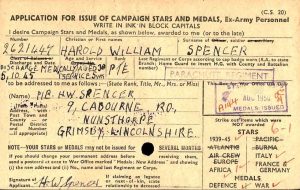
FWR Tip: WW1 medals were automatically issued to Other Ranks (non-officers) or their next of kin. However, for WW2 medals, everyone had to apply, regardless of rank or if they were the next of kin of a soldier.
What information can you find on the WW2 army medal cards?
The medal cards indicate the campaign medals your ancestor was entitled to for their service during WW2. This could have been the France and Germany Star for their service in North West Europe or the Burma Star for participating in the brutal Burma Campaign, amongst others listed on the cards.
Aside from medal entitlement, the cards offer family historians vital clues for researching a military ancestor: the service person’s name, rank, number, last regiment, and discharge date. The person’s address and sometimes age are also featured on the card. You’ll also see the service person’s signature, which adds a poignant, personal element to the cards.
Why are the WW2 army medal cards important for researchers?
Finding a family member in the WW2 army medal cards collection has the potential to be an exciting discovery and a significant moment in your research journey. Your ancestor’s medal card helps you establish a connection to this pivotal moment in British history and allows you to explore your family’s involvement in the war. Family stories may suggest that a parent or grandparent served in the army, and you may know where they were sent. Finding a card can confirm these family stories or provide new avenues of research.
Personal details included on the cards, like the person’s age (or Service Group Number) and address, are essential clues and can help you identify a family member in the collection with greater confidence. The importance of finding your family member in this collection cannot be understated. We hear many stories from our community and during our Facebook Live Q&As about the difficulties of researching a WW2 ancestor, especially when you have little or no information to work with or when researching someone with a popular name. In addition, some people enlisted with false names or were underage, which makes it very challenging to identify them in the military records. The clues recorded on the medal cards have the potential to help you break down these challenging brick walls and kickstart your research.
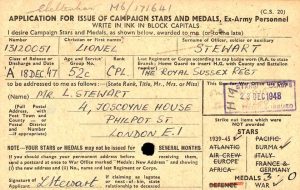
What can I do with the information on a WW2 medal card?
Military details included on the cards, like the service person’s number and regiment, are essential pieces of the puzzle. With the help of this information, you can confidently search for your ancestors in other military collections. This opens up many exciting new avenues for research in a wide range of collections: service records, casualty records, gallantry awards, POW collections, tracer cards, daily reports and war diaries, to name a sample.
FWR Tip: Unlike WW1 medals, WW2 medals are not engraved with the service person’s basic military details.
What other units can you find in the WW2 army medal cards?
In addition to the British Army, cards exist for British colonial regiments or ‘overseas’ units within the British Army or administered by the War Office, like the King’s African Rifles or the Royal Malta Artillery.
The new collection also helps us research our female ancestors who served during the war, with cards covering the Auxiliary Territorial Service, the women’s branch of the army. The nursing services are also featured to some degree, with cards available for members of Queen Alexandra’s Imperial Military Nursing Service and the Territorial Force Nursing Service.
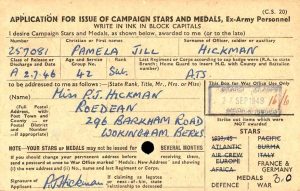
FWR Tips: When searching for a regiment, try searching for the full name and an abbreviation, like ‘Regt’. It is also worth searching for acronyms, like ‘RAMC’ for the Royal Army Medical Corps.
What medals appear on the WW2 army medal cards?
Below are the campaign medals detailed on the WW2 army medal cards, some of which your ancestor may have been entitled to. Perhaps you have your ancestor’s medals, and you recognise them in the list below:

Are there different types of WW2 army medal cards or documents in the collection?
The majority of the medal cards follow the same format and appear on the same standard printed card with space for the applicant’s details. Some cards contain receipts stapled to the back indicating the applicant had received their awards; the receipt does not obscure any unique information.
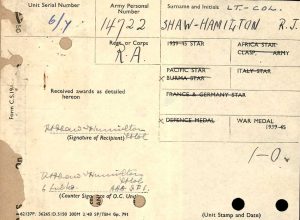
On rare occasions, the applicant provided a cover letter or correspondence relating to the medal application, which has also been scanned and included in the collection. Such correspondence represents an interesting and personal discovery and could contain useful contextual information for the reader.
FWR Tip: Looking for more advice on researching WW2 family members? Our handy guide has you covered.
What information is redacted on the WW2 army medal cards?
If the next of kin has applied for a service person’s medals, the applicant’s details will be redacted (not the service person’s details). Employing a 100-year rule, the next-of-kin’s details will be redacted for 82 years from the medals’ issue date stamp, assuming the applicants were at least 18 years of age.
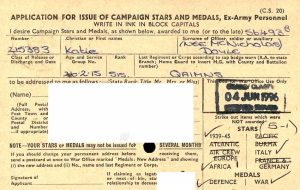
Why can’t I find my ancestor’s medal card?
If a soldier does not have a card in the collection, one possibility is that they or their next of kin never applied for the medals.
Another factor is that some records for the following regiments were destroyed before being transferred to TNA. Some have survived and are available in the collection, but the number varies:
| Royal Engineers | Royal Army Veterinary Corps | Royal Army Medical Corps |
| Royal Army Ordnance Corps | Auxiliary Territorial Service | Scots Guards |
| The Leicestershire Regiment | The Royal Warwickshire Regiment | The Lincolnshire Regiment |
| The West Yorkshire Regiment | The East Yorkshire Regiment | The Green Howards |
| The Duke of Wellington’s Regiment | The Sherwood Foresters | The York and Lancaster Regiment |
| The Royal Northumberland Fusiliers | The Royal Ulster Rifles | The Royal Inniskilling Fusiliers |
| The Royal Irish Fusiliers | The King’s Own Regiment | The Lancashire Fusiliers |
| The Border Regiment | The East Lancashire Regiment | The South Lancashire Regiment |
| The Loyal Regiment | The Manchester Regiment | The Welch Regiment |
| The Cheshire Regiment | The Worcester Regiment | The South Staffordshire Regiment |
| The North Staffordshire Regiment | The South Wales Borderers | The Royal Welch Fusiliers |
| The Liverpool Regiment |
FWR Tip: Try searching for your aunts and uncles or great aunts and great uncles in the collection. You may identify a new military ancestor.
Other reasons for absent medal cards
Owing to data protection law, the cards can be published after 100 years have elapsed from the individual’s date of birth. We will continue to add cards and update the collection in accordance with these regulations.
Search the WW2 army medal cards.
Cover image: ©The National Archives

